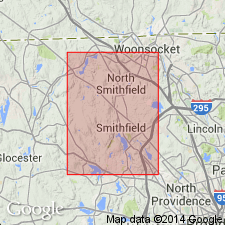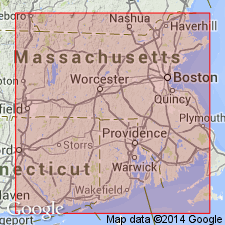
- Usage in publication:
-
- Absalona formation*
- Modifications:
-
- Original reference
- Dominant lithology:
-
- Gneiss
- Schist
- Amphibolite
- AAPG geologic province:
-
- New England province
Summary:
Pg. 10, 11-12, pl. 1. Absalona formation. Predominantly porphyroblastic biotite gneiss; includes, locally, lenses of quartz-biotite schist at its base and mappable units of biotite gneiss and amphibolite in its upper part; small quartzite lenses occur throughout. Thickness 650 to 4,700 feet. Underlies Woonasquatucket formation (new); overlies Nipsachuck gneiss (new). Age is Precambrian(?).
Named from exposures on southwest slope of Absalona Hill along U.S. Route 44, Georgiaville quadrangle, [north-central] RI.
Source: US geologic names lexicon (USGS Bull. 1200, p. 14).

- Usage in publication:
-
- Absalona Formation
- Modifications:
-
- Revised
- Overview
- Dominant lithology:
-
- Schist
- Gneiss
- AAPG geologic province:
-
- New England province
Summary:
Pg. 24 (table 2), 27-28. Absalona Formation of Harmony Complex (text); Absalona Gneiss of Harmony Complex (table 2). On p. 28 described as dark gray biotite schist or gneiss with prominent pink to gray microcline porphyroblasts and round, blue and colorless quartz grains. Characterized by elongated streaks of black, gray, and white schistose lenticles which authors interpret to be mylonitized volcanic fragments. On p. 24 (table 2) described as a dark gray to gray, medium- to coarse-grained, porphyroblastic biotite gneiss with inclusions of quartz-biotite schist and quartz-epidote nodules (epicule). Protolith is dominantly granitic to biotite-rich granitic rocks with some felsic volcanic rocks with many basaltic fragments now highly tectonized and, in part, mylonized. [Thickness not stated. Underlies(?) Woonasquatucket Formation of Harmony Complex.] Intruded by Nipsachuck Gneiss of Harmony Complex; [in table 2 the Nipsachuck is shown as basal unit of the Harmony Complex]. Age is Late Proterozoic.
See also Quinn, 1971; Skehan, 1983, p. 287; Watson, 1989.
Source: Publication.
For more information, please contact Nancy Stamm, Geologic Names Committee Secretary.
Asterisk (*) indicates published by U.S. Geological Survey authors.
"No current usage" (†) implies that a name has been abandoned or has fallen into disuse. Former usage and, if known, replacement name given in parentheses ( ).
Slash (/) indicates name conflicts with nomenclatural guidelines (CSN, 1933; ACSN, 1961, 1970; NACSN, 1983, 2005, 2021). May be explained within brackets ([ ]).

